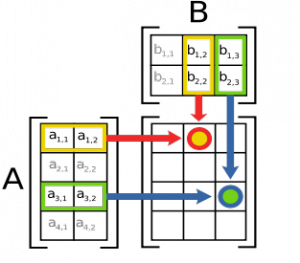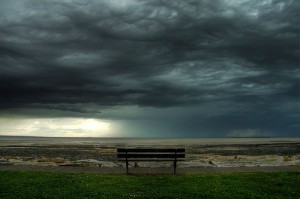I was trying to write a video to a file using the CvVideoWriter structure, but nothing was being written. I received no errors, nothing. The program would run, everything would go as expected, but the video would not write. This was my code.
..... more code here .....
CvVideoWriter *writer = cvCreateVideoWriter( argv[ 1 ],
CV_FOURCC('R','I','F','F'),
70,
size
);
..... more code here .....
cvWriteFrame( writer, bgr_frame );
..... more code here .....
After a bit of testing, what hinted me to the problem was placing this code in my program
CvVideoWriter *writer = cvCreateVideoWriter( argv[ 1 ],
CV_FOURCC('R','I','F','F'),
70,
size
);
if ( writer == NULL )
printf("writer is NULL\n");
if ( writer == false)
printf("writer is false\n");
This lead me to believe that the cvCreateVideoWriter function was returning, false, to my writer stucture. So when cvWriteFrame was called it did nothing. I wanted to know why, so I looked through the source to find the definition of the cvCreateVideoWriter function, this is what I found.
CvVideoWriter* cvCreateVideoWriter( const char* filename,
int fourcc,
double fps,
CvSize frameSize,
int isColor )
{
CvVideoWriter_FFMPEG* writer = new CvVideoWriter_FFMPEG;
if(writer->open(filename, fourcc, fps, frameSize, isColor != 0))
return writer;
delete writer;
return 0;
}
So I saw here that what was truly returning the NULL was the writer objects open() function, the next step was to hunt it down. After testing some of the function’s modules which returned a NULL pointer, this is what I found.
bool CvVideoWriter::open( const char * filename, int fourcc,
double fps, CvSize frameSize, bool is_color )
{
..... code code code .....
..... code code code .....
/* Lookup codec_id for given fourcc */
#if LIBAVCODEC_VERSION_INT<((51<<16)+(49<<8)+0)
if((codec_id = codec_get_bmp_id( fourcc )) == CODEC_ID_NONE )
return false;
#else
const struct AVCodecTag * tags[] = { codec_bmp_tags, NULL};
if((codec_id = av_codec_get_id(tags, fourcc)) == CODEC_ID_NONE)
return false;
#endif
..... code code code .....
..... code code code .....
return true;
}
This hint took me to my final conclusion. I decided to look through the codec support in OpenCV, I found this big list of codecs only to be disappointed that the codec I was putting into my function wasn’t listed here! So I replaced it with one on the list that was also on my computer. If you’re having this problem look through this list to see if your codec is here.
FIX: Just replace the codec with one of the codecs on this list, that is also on your computer.
typedef struct AVCodecTag {
int id;
unsigned int tag;
} AVCodecTag;
const AVCodecTag codec_bmp_tags[] = {
{ CODEC_ID_H264, MKTAG('H', '2', '6', '4') },
{ CODEC_ID_H264, MKTAG('h', '2', '6', '4') },
{ CODEC_ID_H264, MKTAG('X', '2', '6', '4') },
{ CODEC_ID_H264, MKTAG('x', '2', '6', '4') },
{ CODEC_ID_H264, MKTAG('a', 'v', 'c', '1') },
{ CODEC_ID_H264, MKTAG('V', 'S', 'S', 'H') },
{ CODEC_ID_H263, MKTAG('H', '2', '6', '3') },
{ CODEC_ID_H263P, MKTAG('H', '2', '6', '3') },
{ CODEC_ID_H263I, MKTAG('I', '2', '6', '3') }, /* intel h263 */
{ CODEC_ID_H261, MKTAG('H', '2', '6', '1') },
/* added based on MPlayer */
{ CODEC_ID_H263P, MKTAG('U', '2', '6', '3') },
{ CODEC_ID_H263P, MKTAG('v', 'i', 'v', '1') },
{ CODEC_ID_MPEG4, MKTAG('F', 'M', 'P', '4') },
{ CODEC_ID_MPEG4, MKTAG('D', 'I', 'V', 'X') },
{ CODEC_ID_MPEG4, MKTAG('D', 'X', '5', '0') },
{ CODEC_ID_MPEG4, MKTAG('X', 'V', 'I', 'D') },
{ CODEC_ID_MPEG4, MKTAG('M', 'P', '4', 'S') },
{ CODEC_ID_MPEG4, MKTAG('M', '4', 'S', '2') },
{ CODEC_ID_MPEG4, MKTAG(0x04, 0, 0, 0) }, /* some broken avi use this */
/* added based on MPlayer */
{ CODEC_ID_MPEG4, MKTAG('D', 'I', 'V', '1') },
{ CODEC_ID_MPEG4, MKTAG('B', 'L', 'Z', '0') },
{ CODEC_ID_MPEG4, MKTAG('m', 'p', '4', 'v') },
{ CODEC_ID_MPEG4, MKTAG('U', 'M', 'P', '4') },
{ CODEC_ID_MPEG4, MKTAG('W', 'V', '1', 'F') },
{ CODEC_ID_MPEG4, MKTAG('S', 'E', 'D', 'G') },
{ CODEC_ID_MPEG4, MKTAG('R', 'M', 'P', '4') },
{ CODEC_ID_MSMPEG4V3, MKTAG('D', 'I', 'V', '3') }, /* default signature when using MSMPEG4 */
{ CODEC_ID_MSMPEG4V3, MKTAG('M', 'P', '4', '3') },
/* added based on MPlayer */
{ CODEC_ID_MSMPEG4V3, MKTAG('M', 'P', 'G', '3') },
{ CODEC_ID_MSMPEG4V3, MKTAG('D', 'I', 'V', '5') },
{ CODEC_ID_MSMPEG4V3, MKTAG('D', 'I', 'V', '6') },
{ CODEC_ID_MSMPEG4V3, MKTAG('D', 'I', 'V', '4') },
{ CODEC_ID_MSMPEG4V3, MKTAG('A', 'P', '4', '1') },
{ CODEC_ID_MSMPEG4V3, MKTAG('C', 'O', 'L', '1') },
{ CODEC_ID_MSMPEG4V3, MKTAG('C', 'O', 'L', '0') },
{ CODEC_ID_MSMPEG4V2, MKTAG('M', 'P', '4', '2') },
/* added based on MPlayer */
{ CODEC_ID_MSMPEG4V2, MKTAG('D', 'I', 'V', '2') },
{ CODEC_ID_MSMPEG4V1, MKTAG('M', 'P', 'G', '4') },
{ CODEC_ID_WMV1, MKTAG('W', 'M', 'V', '1') },
/* added based on MPlayer */
{ CODEC_ID_WMV2, MKTAG('W', 'M', 'V', '2') },
{ CODEC_ID_DVVIDEO, MKTAG('d', 'v', 's', 'd') },
{ CODEC_ID_DVVIDEO, MKTAG('d', 'v', 'h', 'd') },
{ CODEC_ID_DVVIDEO, MKTAG('d', 'v', 's', 'l') },
{ CODEC_ID_DVVIDEO, MKTAG('d', 'v', '2', '5') },
{ CODEC_ID_MPEG1VIDEO, MKTAG('m', 'p', 'g', '1') },
{ CODEC_ID_MPEG1VIDEO, MKTAG('m', 'p', 'g', '2') },
{ CODEC_ID_MPEG2VIDEO, MKTAG('m', 'p', 'g', '2') },
{ CODEC_ID_MPEG2VIDEO, MKTAG('M', 'P', 'E', 'G') },
{ CODEC_ID_MPEG1VIDEO, MKTAG('P', 'I', 'M', '1') },
{ CODEC_ID_MPEG1VIDEO, MKTAG('V', 'C', 'R', '2') },
{ CODEC_ID_MPEG1VIDEO, 0x10000001 },
{ CODEC_ID_MPEG2VIDEO, 0x10000002 },
{ CODEC_ID_MPEG2VIDEO, MKTAG('D', 'V', 'R', ' ') },
{ CODEC_ID_MPEG2VIDEO, MKTAG('M', 'M', 'E', 'S') },
{ CODEC_ID_MJPEG, MKTAG('M', 'J', 'P', 'G') },
{ CODEC_ID_MJPEG, MKTAG('L', 'J', 'P', 'G') },
{ CODEC_ID_LJPEG, MKTAG('L', 'J', 'P', 'G') },
{ CODEC_ID_MJPEG, MKTAG('J', 'P', 'G', 'L') }, /* Pegasus lossless JPEG */
{ CODEC_ID_MJPEG, MKTAG('M', 'J', 'L', 'S') }, /* JPEG-LS custom FOURCC for avi - decoder */
{ CODEC_ID_MJPEG, MKTAG('j', 'p', 'e', 'g') },
{ CODEC_ID_MJPEG, MKTAG('I', 'J', 'P', 'G') },
{ CODEC_ID_MJPEG, MKTAG('A', 'V', 'R', 'n') },
{ CODEC_ID_HUFFYUV, MKTAG('H', 'F', 'Y', 'U') },
{ CODEC_ID_FFVHUFF, MKTAG('F', 'F', 'V', 'H') },
{ CODEC_ID_CYUV, MKTAG('C', 'Y', 'U', 'V') },
{ CODEC_ID_RAWVIDEO, 0 },
{ CODEC_ID_RAWVIDEO, MKTAG('I', '4', '2', '0') },
{ CODEC_ID_RAWVIDEO, MKTAG('Y', 'U', 'Y', '2') },
{ CODEC_ID_RAWVIDEO, MKTAG('Y', '4', '2', '2') },
{ CODEC_ID_RAWVIDEO, MKTAG('Y', 'V', '1', '2') },
{ CODEC_ID_RAWVIDEO, MKTAG('U', 'Y', 'V', 'Y') },
{ CODEC_ID_RAWVIDEO, MKTAG('I', 'Y', 'U', 'V') },
{ CODEC_ID_RAWVIDEO, MKTAG('Y', '8', '0', '0') },
{ CODEC_ID_RAWVIDEO, MKTAG('H', 'D', 'Y', 'C') },
{ CODEC_ID_INDEO3, MKTAG('I', 'V', '3', '1') },
{ CODEC_ID_INDEO3, MKTAG('I', 'V', '3', '2') },
{ CODEC_ID_VP3, MKTAG('V', 'P', '3', '1') },
{ CODEC_ID_VP3, MKTAG('V', 'P', '3', '0') },
{ CODEC_ID_ASV1, MKTAG('A', 'S', 'V', '1') },
{ CODEC_ID_ASV2, MKTAG('A', 'S', 'V', '2') },
{ CODEC_ID_VCR1, MKTAG('V', 'C', 'R', '1') },
{ CODEC_ID_FFV1, MKTAG('F', 'F', 'V', '1') },
{ CODEC_ID_XAN_WC4, MKTAG('X', 'x', 'a', 'n') },
{ CODEC_ID_MSRLE, MKTAG('m', 'r', 'l', 'e') },
{ CODEC_ID_MSRLE, MKTAG(0x1, 0x0, 0x0, 0x0) },
{ CODEC_ID_MSVIDEO1, MKTAG('M', 'S', 'V', 'C') },
{ CODEC_ID_MSVIDEO1, MKTAG('m', 's', 'v', 'c') },
{ CODEC_ID_MSVIDEO1, MKTAG('C', 'R', 'A', 'M') },
{ CODEC_ID_MSVIDEO1, MKTAG('c', 'r', 'a', 'm') },
{ CODEC_ID_MSVIDEO1, MKTAG('W', 'H', 'A', 'M') },
{ CODEC_ID_MSVIDEO1, MKTAG('w', 'h', 'a', 'm') },
{ CODEC_ID_CINEPAK, MKTAG('c', 'v', 'i', 'd') },
{ CODEC_ID_TRUEMOTION1, MKTAG('D', 'U', 'C', 'K') },
{ CODEC_ID_MSZH, MKTAG('M', 'S', 'Z', 'H') },
{ CODEC_ID_ZLIB, MKTAG('Z', 'L', 'I', 'B') },
{ CODEC_ID_SNOW, MKTAG('S', 'N', 'O', 'W') },
{ CODEC_ID_4XM, MKTAG('4', 'X', 'M', 'V') },
{ CODEC_ID_FLV1, MKTAG('F', 'L', 'V', '1') },
{ CODEC_ID_SVQ1, MKTAG('s', 'v', 'q', '1') },
{ CODEC_ID_TSCC, MKTAG('t', 's', 'c', 'c') },
{ CODEC_ID_ULTI, MKTAG('U', 'L', 'T', 'I') },
{ CODEC_ID_VIXL, MKTAG('V', 'I', 'X', 'L') },
{ CODEC_ID_QPEG, MKTAG('Q', 'P', 'E', 'G') },
{ CODEC_ID_QPEG, MKTAG('Q', '1', '.', '0') },
{ CODEC_ID_QPEG, MKTAG('Q', '1', '.', '1') },
{ CODEC_ID_WMV3, MKTAG('W', 'M', 'V', '3') },
{ CODEC_ID_LOCO, MKTAG('L', 'O', 'C', 'O') },
{ CODEC_ID_THEORA, MKTAG('t', 'h', 'e', 'o') },
#if LIBAVCODEC_VERSION_INT>0x000409
{ CODEC_ID_WNV1, MKTAG('W', 'N', 'V', '1') },
{ CODEC_ID_AASC, MKTAG('A', 'A', 'S', 'C') },
{ CODEC_ID_INDEO2, MKTAG('R', 'T', '2', '1') },
{ CODEC_ID_FRAPS, MKTAG('F', 'P', 'S', '1') },
{ CODEC_ID_TRUEMOTION2, MKTAG('T', 'M', '2', '0') },
#endif
#if LIBAVCODEC_VERSION_INT>((50<<16)+(1<<8)+0)
{ CODEC_ID_FLASHSV, MKTAG('F', 'S', 'V', '1') },
{ CODEC_ID_JPEGLS,MKTAG('M', 'J', 'L', 'S') }, /* JPEG-LS custom FOURCC for avi - encoder */
{ CODEC_ID_VC1, MKTAG('W', 'V', 'C', '1') },
{ CODEC_ID_VC1, MKTAG('W', 'M', 'V', 'A') },
{ CODEC_ID_CSCD, MKTAG('C', 'S', 'C', 'D') },
{ CODEC_ID_ZMBV, MKTAG('Z', 'M', 'B', 'V') },
{ CODEC_ID_KMVC, MKTAG('K', 'M', 'V', 'C') },
#endif
#if LIBAVCODEC_VERSION_INT>((51<<16)+(11<<8)+0)
{ CODEC_ID_VP5, MKTAG('V', 'P', '5', '0') },
{ CODEC_ID_VP6, MKTAG('V', 'P', '6', '0') },
{ CODEC_ID_VP6, MKTAG('V', 'P', '6', '1') },
{ CODEC_ID_VP6, MKTAG('V', 'P', '6', '2') },
{ CODEC_ID_VP6F, MKTAG('V', 'P', '6', 'F') },
{ CODEC_ID_JPEG2000, MKTAG('M', 'J', '2', 'C') },
{ CODEC_ID_VMNC, MKTAG('V', 'M', 'n', 'c') },
#endif
#if LIBAVCODEC_VERSION_INT>=((51<<16)+(49<<8)+0)
// this tag seems not to exist in older versions of FFMPEG
{ CODEC_ID_TARGA, MKTAG('t', 'g', 'a', ' ') },
#endif
{ CODEC_ID_NONE, 0 },
};





